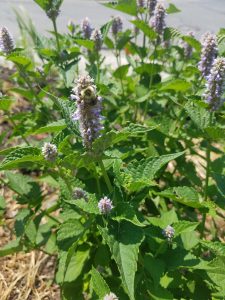Anise Hyssop
(Agastache foeniculum)

Anise Hyssop is an herbaceous perennial growing about 1m tall with mild branching. It has spade-like, mildly serrated leaves that are soft to the touch, and tall clusters of small purple flowers that bloom from July to September. When crushed slightly, the leaves and flowers smell strongly of sweet licorice. This is a great perennial plant when considering developing a pollinator garden or just to attract more pollinators to your garden!
Cultivation Tips
Anise Hyssop is easy to grow from seed if placed on top of loose soil and kept moist, but can also be grown from cuttings of established plants placed in loose, moist soil. It prefers full sun, but will still grow well and flower in partial shade. Anise Hyssop is tolerant of most soil types and is relatively drought tolerant but requires good drainage. Clipping the tops of the plants after the fourth or fifth leaf node and removing flower stalks that form before August will encourage branching and a bushier plant, and may lead to more overall foliage being produced in the season.
In early/mid September, when the flowers begin to turn brown, clip off the entire flower stalk and place it cut-side-up in a paper bag. Allow them to dry for 1-2 weeks, agitating occasionally, until the seeds fall out of the casings into the bottom of the bag. Once dry, seeds can be saved for 2-3 years if kept in a cool, dark place.
The previous year’s growth should be cut back and composted in late winter to encourage vigorous regrowth from the root system.
Uses
Anise Hyssop is an excellent source of pollen and nectar for a variety of pollinators and predatory insects. The leaves and flowers make an excellent tea, and are said to have been used by Native Americans to treat coughs, fevers, and diarrhea. It also has calming and mildly sedative effects, making it useful for a Stress-Free Hyssop Tea! Due to its strong fragrance, deer and rabbits tend not to go near it, making it a useful guard plant for allowing young, more tender perennials to get established.
Companion Plants
Anise Hyssop should be planted around perennials that are intriguing to deer while they are young, such as hazelnut, persimmon, and cherry, to allow them to get established. Anise Hyssop also attracts predatory insects, making it a good companion to leafy greens that get heavy insect pressure.